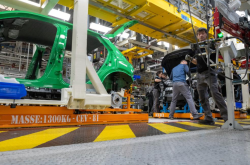Behind the Explosion of MCP: Is the Era of AI Agent Productivity Here?
![]() 04/27 2025
04/27 2025
![]() 594
594
While an absolute 'unified protocol' may never materialize, the standards revolution ignited by MCP has unleashed a torrent of AI productivity.
Author | Dou Dou
Editor | Pi Ye
Produced by | Industry Home
In July 2024, in a San Francisco office, Anthropic engineer David Soria Parra stared frustratedly at his monitor. As he pondered how to deeply integrate existing models across the workforce, he found Claude Desktop lacking in functionality and expandability, while the IDE fell short of Claude Desktop's practical tools, forcing him to constantly copy content between the two, a cumbersome process.
"I realized this was an 'MxN' problem – the challenge of multiple applications and integrations – and a protocol was the perfect solution," he said.
After weeks of contemplation, David conceived an idea: to create something akin to LSP to standardize the 'communication between AI applications and extensions.' He approached Anthropic engineer Justin, and they immediately hit it off, embarking on construction.
Four months later, their idea materialized and was presented to the public – this was MCP.
Today, MCP is widely discussed across platforms, with multiple large model service providers announcing support. In the secondary market, MCP concept stocks have surged in trading.
Amidst the excitement, questions persist: Why is MCP so popular? Can it become a true universal standard? What commercial rationale drives large model vendors to rush to connect? Furthermore, does MCP's popularity signify the dawn of the AI Agent productivity era?
I. MCP: The 'USB-C Interface' for AI Applications
For a long time, integrating AI models with external tools faced dual challenges: high costs for customized development and ensuring system stability. Traditionally, developers had to create dedicated interfaces for each newly connected tool or data source. This 'one-to-one' adaptation method not only wasted resources but also compromised system architecture robustness.
The birth of the MCP protocol aims to address these pain points.
Its core value lies in standardizing interaction rules. With MCP, developers only need to adhere to protocol standards for models and tools to achieve plug-and-play, simplifying the original 'M×N' integration complexity to 'M+N.' This allows AI models to directly call databases, cloud services, and even local applications through MCP without developing separate adaptation layers for each tool.
Currently, MCP has demonstrated robust ecological integration capabilities.
For instance, Anthropic's Claude desktop application connects to the local file system via the MCP server, enabling AI assistants to read document content and generate contextually relevant answers. The development tool Cursor+ achieves seamless task switching within the IDE by installing multiple MCP servers (like Slack, Postgres).
MCP seems to be gradually becoming what Justin envisioned: 'We compare MCP to the USB-C interface for AI applications; it's the universal interface connecting the entire ecosystem.'
However, the journey from MCP's release to its explosion is significant.
In November 2024, MCP was released and quickly garnered the attention of developers and enterprises. However, it wasn't as hot as it is now, as people were uncertain about agents' value or whether solving Agent 'M×N' integration complexity would lead to an AI productivity explosion.
This uncertainty stemmed from the challenging issue of application-side development lagging behind large model technology's continuous upgrades and iterations. Additionally, internet social platforms buzzed with mixed voices about agents, eroding confidence in AI technology's industry adoption. Even with existing promising directions and applications, it was unclear whether AI technology had truly translated into productivity or merely surface-level integration, incapable of decision-making. This required substantial time to verify.
The turning point came with Manus' framework release and OpenAI's official MCP support announcement.
Manus' demonstration of multi-agent collaboration capabilities perfectly illustrated users' ultimate AI productivity expectations. When MCP realized the innovative 'conversation as operation' experience through the chat interface – where users could trigger system-level operations like file management and data retrieval by inputting commands – a cognitive revolution about 'AI truly assisting in completing actual work' began.
This disruptive user experience further elevated MCP's popularity. Manus' release was a crucial factor in boosting MCP's fame.
Besides Manus, OpenAI's announcement also propelled MCP to the height of a 'universal interface.'
On March 27, 2025, OpenAI announced a significant update to its core development tool AgentSDK, officially supporting the MCP service protocol. When this giant, holding 40% of the global model market share, announced protocol support, it meant MCP began possessing underlying infrastructure attributes akin to HTTP, officially entering the public eye with its popularity skyrocketing.
This revealed the potential for 'HTTP in the AI world' to become a reality. Subsequently, platforms like Cursor, Winsurf, and Cline successively connected to the MCP protocol, and the Agent ecosystem created by MCP gradually expanded.
II. If MCP is Here, Is the Agent Ecosystem Far Behind?
Can MCP truly become the de facto standard for future AI interaction?
On March 11, LangChain co-founder Harrison Chase and LangGraph head Nuno Campos engaged in a heated debate on whether MCP would become the de facto standard for future AI interaction. Although inconclusive, it sparked immense imagination about MCP.
Notably, during this debate, LangChain conducted an online poll. The results were astonishing: 40% of participants supported MCP becoming the future standard.
In this poll, the remaining 60% of non-voters made the path for MCP to become the de facto standard for future AI interaction seem bumpy.
What are their concerns?
The most noteworthy is the disconnect between technical standards and commercial interests, evident in players' actions domestically and internationally post-MCP release.
Shortly after Anthropic released MCP, Google launched A2A (Agent to Agent).
If MCP paves the way for individual agents to easily reach various 'resource points,' A2A aims to build a vast communication network connecting these agents, enabling them to 'talk' and collaborate.
Essentially, whether it's MCP or A2A, the core is the competition for the Agent ecosystem.
So, what trend is the domestic market exhibiting now?
Specifically, actions are concentrated on large model vendors. Since April, Alibaba, Tencent, and Baidu have successively announced support for the MCP protocol.
Alibaba Cloud's Bailian platform launched the industry's first full-lifecycle MCP service on April 9, integrating over 50 tools like Gaode Maps and Wuying Cloud Desktop, allowing exclusive Agents to be generated in just 5 minutes. Alipay, in collaboration with ModelScope, was the first to introduce the 'Payment MCP Server' service in China, enabling AI agents to access payment capabilities with a single click.
On April 14, Tencent Cloud upgraded its large model knowledge engine to support MCP plugin invocation and access to ecological tools like Tencent Location Services and WeChat Reading. On April 16, Alipay launched the 'Payment MCP Server,' enabling developers to swiftly access payment functions through natural language commands, bridging the AI services commercialization loop. On April 25, Baidu announced full MCP protocol compatibility and launched the world's first e-commerce transaction MCP and search MCP services. The Intelligent Cloud Qianfan platform accessed third-party MCP Servers, with the search platform indexing resources across the entire network to reduce development costs.
It's evident that domestic large model vendors' approach to MCP is a 'full closed loop.' From Alibaba Cloud's Bailian platform MCP service integrating Gaode Maps to Tencent Cloud supporting MCP plugin invocation and accessing the WeChat Reading ecosystem, to Baidu launching search MCP services, they all leverage MCP to play to their strengths and reinforce their ecological barriers.
There's a profound commercial logic behind this strategic choice.
Imagine if the Alibaba Cloud platform allowed Baidu Map services invocation, or if Tencent's ecosystem opened its core data interfaces to external models. The differentiated advantages built through painstaking data and ecological moats by each vendor would potentially collapse. It's this demand for absolute control over the 'right to connect' that makes MCP, under the guise of technical standardization, quietly redistribute AI era infrastructure control.
The tension in this contradiction is emerging: on the surface, MCP drives technical protocol standardization through unified interface specifications; essentially, each platform defines its own connection rules through privatized protocols.
This separation of open protocols and ecosystems will inevitably become a profound obstacle hindering MCP from becoming a truly universal standard.
III. In the Wave of AI Industrial Landing, Revisiting the True Value of MCP
While an absolute 'unified protocol' may never emerge, the standards revolution ignited by MCP has unleashed a torrent of AI productivity.
Currently, each large model vendor is building its own 'ecological enclave' through the MCP protocol. This 'full closed loop' strategy will expose the Agent ecosystem's underlying fragmentation contradiction. However, it can also unleash ecological builders' accumulated capabilities, rapidly forming an application matrix, and promoting AI landing.
For instance, large companies' past advantages (like Alipay's payment technology, user scale, and risk control capabilities) were confined to their businesses. But after being opened through standardized interfaces (MCP), these capabilities can be invoked by more external developers. Other companies' AI Agents don't need to build their own payment systems and can directly use Alipay interfaces. This can also attract more participants to utilize large companies' infrastructure, fostering dependency and network effects, expanding the ecosystem's influence.
This 'enclosed innovation' has, to some extent, accelerated AI technology's industrial penetration.
From this perspective, it may drive the future Agent ecosystem towards a 'limited openness' pattern.
Specifically, core data interfaces will remain firmly controlled by large companies. However, in non-core areas, through technical community promotion and regulatory agency intervention, cross-platform 'micro-standards' may gradually form. This 'limited openness' can protect vendors' ecological interests while avoiding a completely fragmented technical ecology.
In this process, MCP's value will shift from being a 'universal interface' to an 'ecosystem connector.'
It will no longer pursue being the sole standardized protocol but will serve as a bridge for different ecosystems to communicate. When developers can easily achieve cross-ecological Agent collaboration through MCP, and users can seamlessly switch between intelligent agent services on different platforms, the Agent ecosystem will truly usher in its golden age.
The premise for all this is whether the industry can find a delicate balance between commercial interests and technical ideals. This is the change MCP brings beyond its tool value.
In fact, the Agent ecosystem's construction doesn't hinge on the emergence of a specific standard protocol. AI's landing doesn't depend on connecting a particular link but on consensus.
Just as Anthropic engineer David initially envisioned: what we need isn't just a 'universal socket' but a 'power grid' allowing sockets to be compatible. And this power grid requires not only technical consensus but also a global dialogue on AI era infrastructure rules.
With AI technology's rapid iteration, under MCP's 'catalysis,' vendors are accelerating the unification of this technical consensus.






